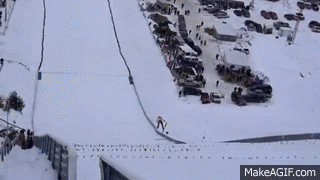Skier follows a curve
 A skier travels with a constant speed of
along a parabolic path
. If the acceleration of the skier when he is at
is
. Neglect the size of skier. Find
A skier travels with a constant speed of
along a parabolic path
. If the acceleration of the skier when he is at
is
. Neglect the size of skier. Find
Details
are co prime natural numbers and is a square free number
The answer is 21.
This section requires Javascript.
You are seeing this because something didn't load right. We suggest you, (a) try
refreshing the page, (b) enabling javascript if it is disabled on your browser and,
finally, (c)
loading the
non-javascript version of this page
. We're sorry about the hassle.
Since the speed is constant there is no tangential acceleration the only acceleration is in radial direction which can be given by
a = r v 2
where r can be calculated by the formula
r = d x 2 d 2 y [ 1 + ( d x d y ) 2 ] 2 3
y = 2 0 x 2
d x d y = 2 0 2 x = 1 0 x
d x 2 d 2 y = d x d ( d x d y ) = d x d ( 1 0 x ) = 1 0 1
Putting in the values we get
d x d y = 1 0 1 0 = 1
r = d x 2 d 2 y [ 1 + ( d x d y ) 2 ] 2 3 = 2 0 2
a = 1 0 9 2
A n s . i s 2 1